
Vietnam is not only a land of breathtaking landscapes but also a haven for food enthusiasts. Among the many Vietnamese cake creations, pia cake, or Vietnamese durian cake, stands out as a unique delicacy. As you embark on a Vietnam travel journey, don't miss the opportunity to savor this delectable treat and bring it back as a souvenir for your friends and loved ones.
1. What is Pia cake? Where is it as a specialty?
Pia cake is a flattened, round cake with multiple thin layers enveloping a rich filling. The exterior boasts thin layers, while the interior consists of a blend of salted egg yolk, green beans, and durian. This delectable pastry emanates the fragrance of durian, featuring an incredibly smooth texture and a delightful sweetness that harmonizes the flavors of green beans and durian.
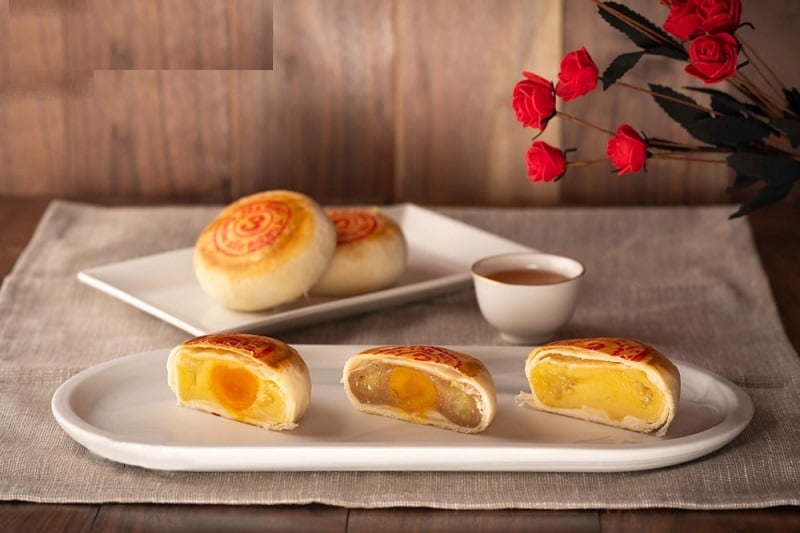
Originating from Chaozhou, China, pia cake has found its way into global communities through Chinese diasporas, notably in Southeast Asia. However, it has become a celebrated specialty in Soc Trang Province, Vietnam, thanks to the creative adaptation by the Chinese immigrants who settled in the region. Over time, the recipe evolved, incorporating variations such as fillings with green beans, durian, or taro, complemented by a salted egg yolk in the center.
>>> Explore more: Vietnamese desserts: TOP 10 must-try sweet treats
2. How is Pia cake made? What is its flavor?
The process of making pia cake Vietnam involves two main components: the cake filling and the cake crust. The filling comes in various types, but the most common are mung bean and taro. Mung beans are soaked, peeled, and steamed before being finely ground, while taro is peeled and similarly steamed. These ingredients are then sauteed with sugar, durian, and lard over low heat to achieve a smooth and fragrant mixture.
The filling also incorporates salted duck egg yolks, surrounded by a layer of winter melon, lard, green beans, durian, and glutinous rice flour. The cake crust consists of two components: one made from a mixture of tapioca and wheat starch (referred to as fatty or oily dough), and the other from a combination of wheat flour, sugar, and a small amount of lard or oil (usually called “water dough” in Vietnamese, but it can be understood as the crust or pastry skin).
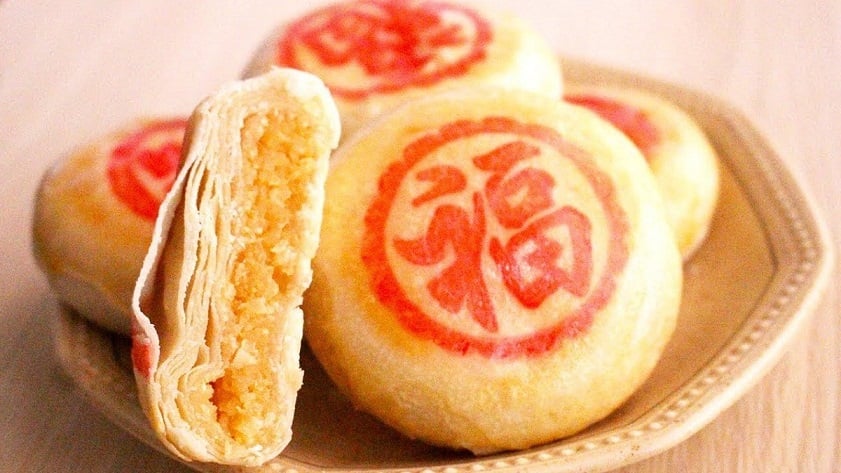
Then, these two components are incorporated through a series of rolling, folding, and pressing actions. The process is somewhat similar to lamination techniques used in Western pastries. This results in a dough with hundreds of alternating layers of fatty dough and pastry skin. The process ensures that the fat layers prevent the crust layers from sticking together while baking, giving the cake its characteristic flaky texture. The final dough is then wrapped around the filling and baked in ovens for a beautiful finish.
>>> Discover: Vietnamese food: Try these dishes to make your trip perfect
3. How many types of Pia cake are there?
3.1. Vietnamese durian cake with green beans
True to its name, this variety features the signature crust, a mung bean and durian filling, and even salted egg yolks. The combination of these ingredients delivers a delightful aroma in a petite cake with a soft, velvety crust that melts on the tongue. The harmonious blend of flavors, including the right amount of sweetness from the cake filling, ensures a satisfying experience without overwhelming the palate.
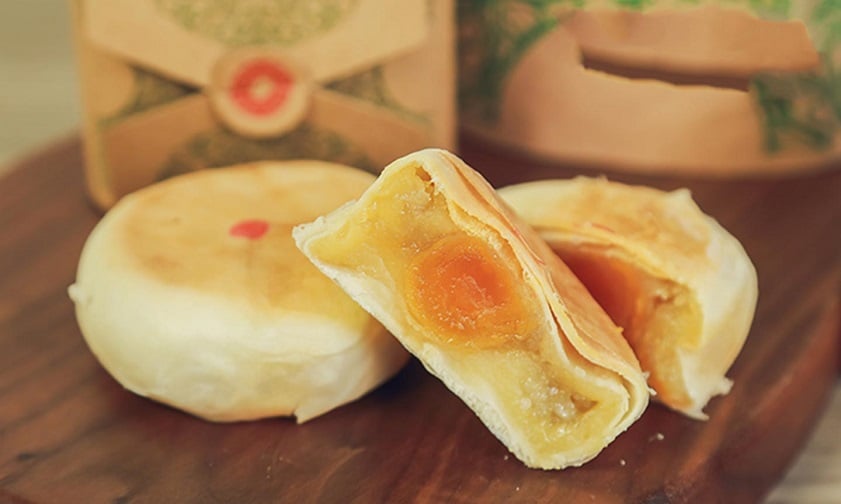
3.2. Vietnamese durian cake with lotus seed
Maintaining the base of tapioca starch, wheat flour, mung beans, durian, and salted duck eggs, this version introduces the unique addition of lotus seeds. This inclusion sets it apart from other pia cakes, offering a distinct texture and nutritional boost with lotus seeds.
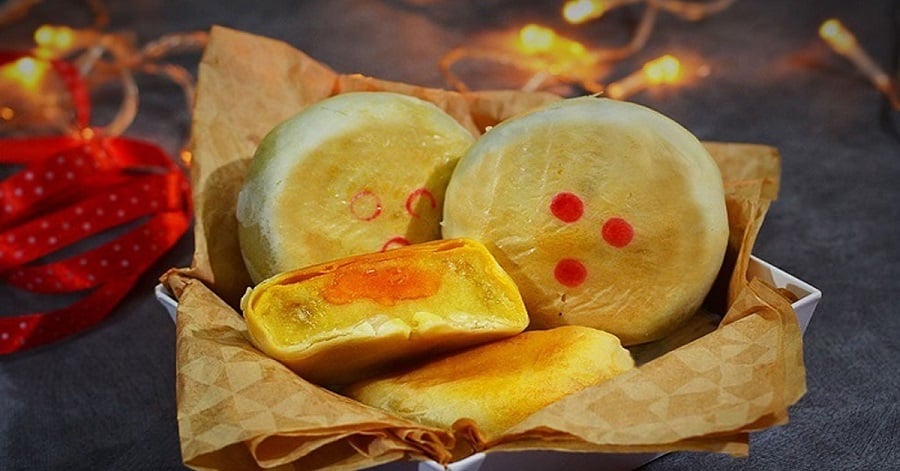
3.3. Vietnamese durian cake with taro
The name itself paints a vivid picture of the uniqueness of this Soc Trang specialty. With the addition of soft, fragrant taro, this ingredient combines seamlessly with other traditional pia cake ingredients to create a delectable treat that captures the essence of the region's culinary heritage.
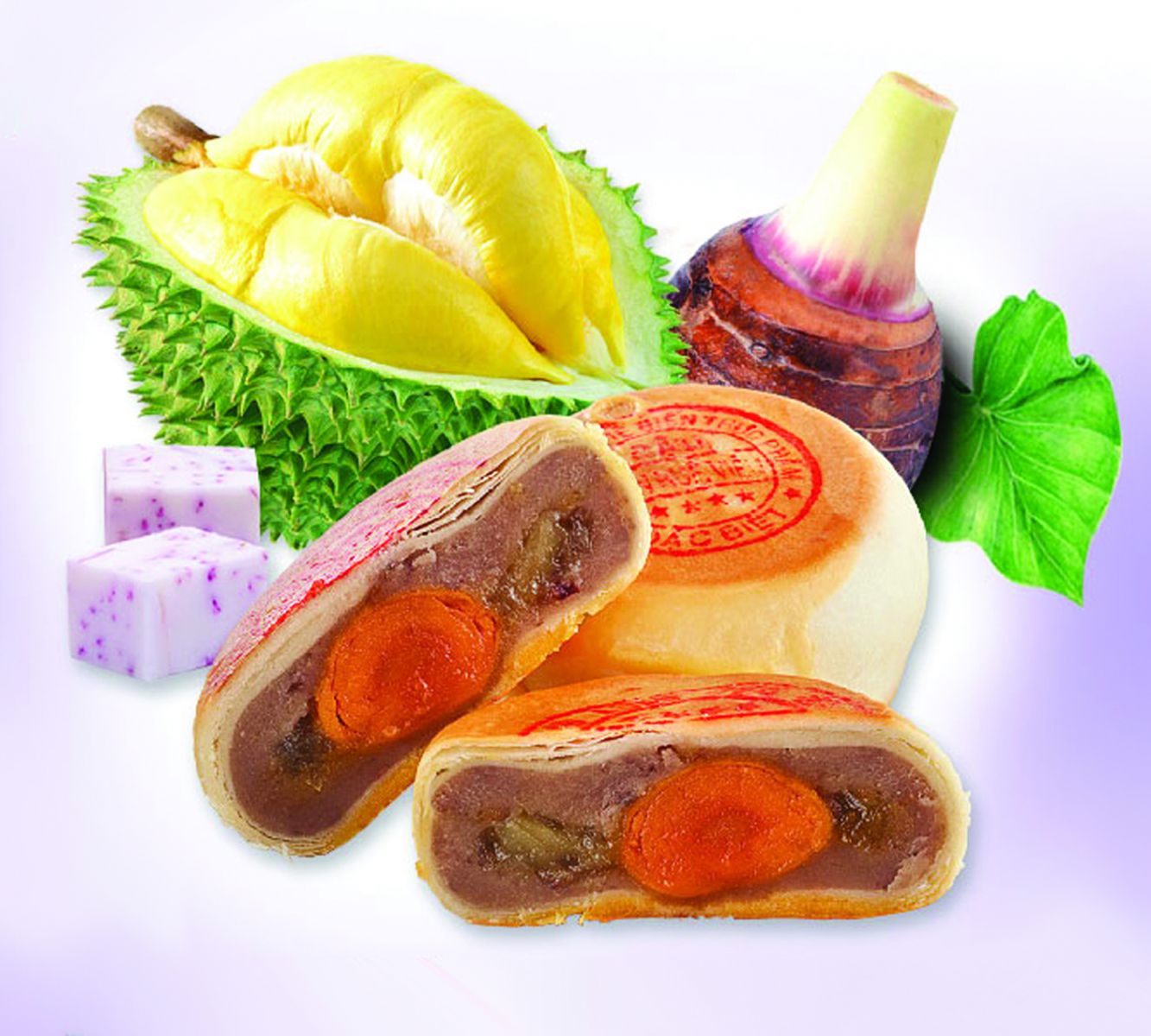
3.4. Vietnamese durian cake with pandan leaf flavor
This type of Vietnamese pia cake is a symphony of traditional mung bean and durian flavors, adorned with a vibrant green hue and the enticing fragrance of pandan leaves. Notably, this version is egg-free, making it suitable for vegetarians while maintaining an irresistible aroma and taste.
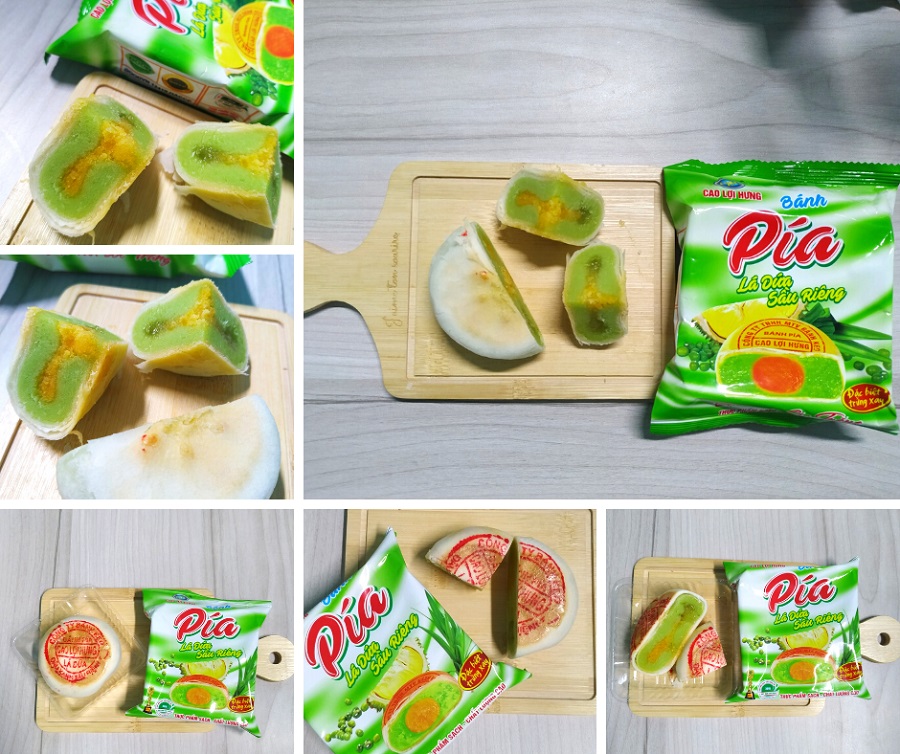
3.5. Other modern variations of Pia cake
Pia cake Vietnam with salted egg is a delightful collaboration of fluffy pork floss and salted egg that results in a visually appealing cake with a bright yellow hue. The softness of the crust, the nuttiness of mung beans, and the saltiness of the salted egg create a harmonious and flavorful combination.
Besides, kim sa pia cake, or saffron pia cake, is also a popular modern variation. Named for its appearance, breaking this cake in half reveals a filling that glitters like saffron. Upon biting into it, you'll experience a luscious melt-in-your-mouth sensation as the filling and crust blend harmoniously. The cake's richness, balanced sweetness, and unique harmony of flavors make it a delightful treat that keeps you coming back for more.
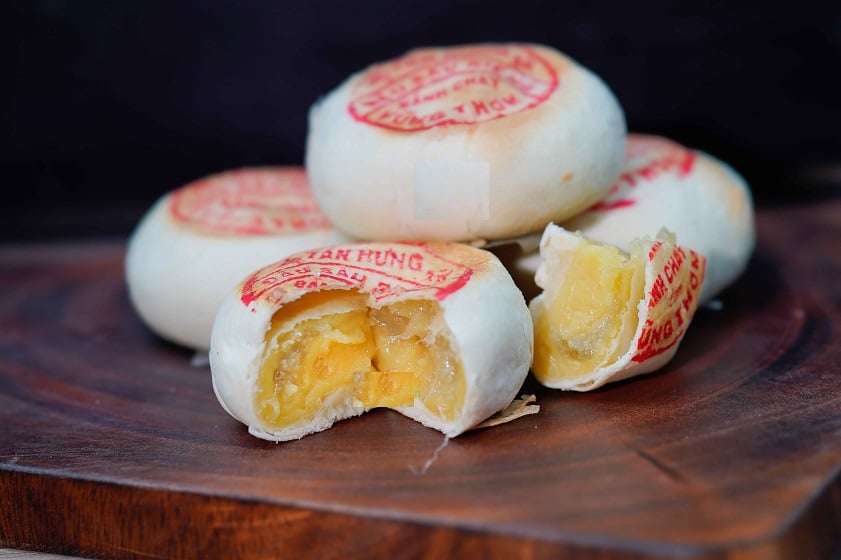
>>> Check out: Vietnamese fruit cake: Discover a sweet culinary delight
4. Useful tips for buying Pia cake on your trip to Vietnam
The average price for a bag of four pia cakes ranges from 60,000 to 100,000 VND. Prices may vary depending on the type, weight, and brand or vendor you choose.
Here are some notable pia cake brands to consider:
- Tan Hue Vien: Tan Hue Vien stands out as one of the most renowned producers of Soc Trang pia cakes. Notably, the cake maintains its integrity when cut, with the crust and filling sticking together, distinguishing it from many other varieties. Tan Hue Vien has expanded its offerings to include variations like taro and pandan-filled pia cakes, providing ample choices for consumers.
- Banh Pia Cong Lap Thanh: A familiar name for over 60 years, Cong Lap Thanh, born in 1963 in the traditional craft village of Vung Thom, has grown into a significant enterprise. Using a special recipe passed down through generations and a team of professionally trained and meticulous bakers, Cong Lap Thanh produces pia cakes known for their quality and traditional flavors.
- Banh Pia Tan Hung: Tan Hung, originating from a small bakery in Vung Thom, is one of the most renowned brands in Soc Trang. While the cakes were once simple, with outer layers made of wheat flour and fillings containing only mung beans and lard, they now come in a variety of flavors, including taro and salted egg yolk. Tan Hung's characteristic lies in its soft and flavorful texture, using premium ingredients to create a distinct taste.
- Banh Pia My Anh: Produced in various provinces in the Mekong Delta, My Anh's pia cakes undergo modern production processes, ensuring strict supervision from ingredient selection to packaging. Known for their excellent quality, My Anh's cakes have a soft and evenly layered crust that rarely breaks when cut. Importantly, they do not contain harmful chemicals or preservatives, ensuring absolute safety for consumers.
- Banh Pia My Hiep Thanh: While My Hiep Thanh may not produce large quantities like many other pia cake establishments in Soc Trang, its unique taste and perfect appearance, thanks to traditional hand wrapping, make it a favorite destination for many customers. Each cake from My Hiep Thanh undergoes a meticulous preparation process, resulting in high-quality products with a luscious filling made from premium ingredients, especially the not overly salty salted egg in this cake.
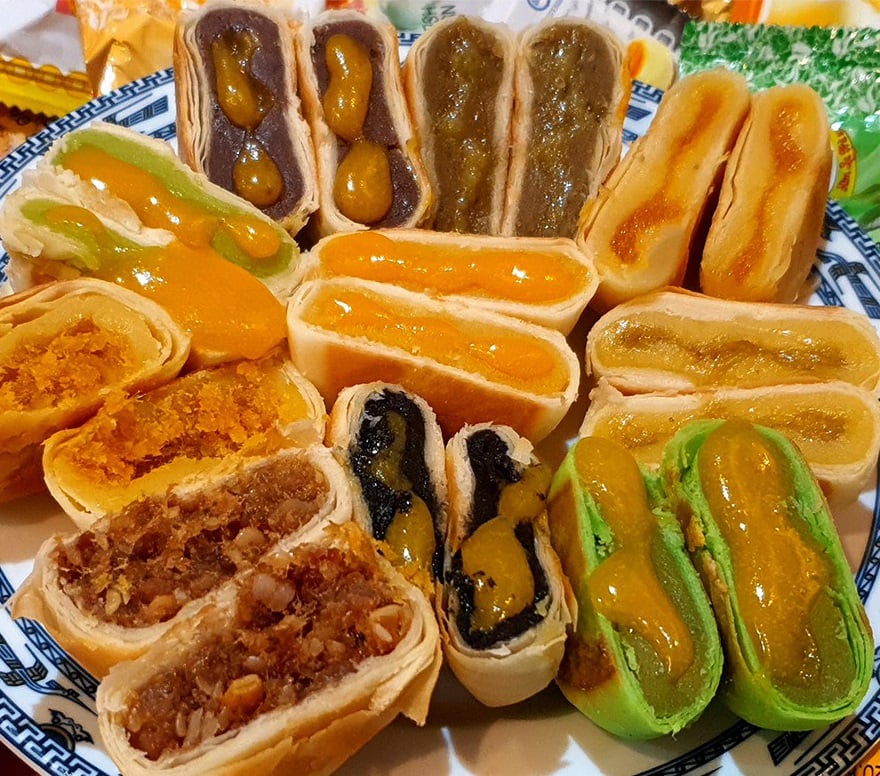
>>> Read on: Vietnamese food souvenirs: The best from each region
Exploring the world of pia cake is not just a culinary journey but a cultural immersion into the heart of Vietnam's rich traditions. As you savor the different flavors and varieties of Vietnam durian cake, you'll not only delight your taste buds but also carry with you a piece of Vietnam's culinary heritage. So, when planning your trip to this beautiful country, make sure to include the delightful pia cake in your gastronomic adventure.
While indulging in pia cake is a must, Vietnam offers a myriad of other culinary delights to explore. From the bustling streets of Hanoi to the vibrant scenes in Ho Chi Minh City, the serene landscapes of Phu Quoc, the coastal charm of Nha Trang, the historic allure of Hoi An, and the breathtaking beauty of Ha Long, each destination promises a unique culinary experience.
It is recommended that you experience the culinary delights and luxurious resort services offered within Vinpearl's extensive hotel and resort network. Vinpearl stands as one of Vietnam's largest hotel chains, boasting locations in the country's most renowned cities. With a myriad of amenities ranging from spas, gyms, and private beaches to attentive services, Vinpearl promises to provide you with a comfortable experience in Vietnam.

And don't forget to explore VinWonders, a chain of amusement parks promising a day filled with joy for you and your loved ones. Immerse yourself in the enchanting world of VinWonders, where thrilling rides, captivating shows, and delightful attractions create an unforgettable experience.
>>> Book rooms in Vinpearl Phu Quoc, Vinpearl Nha Trang, Vinpearl Resort & Golf Nam Hoi An, Vinpearl Resort & Spa Ha Long to elevate your stay in Vietnam
























